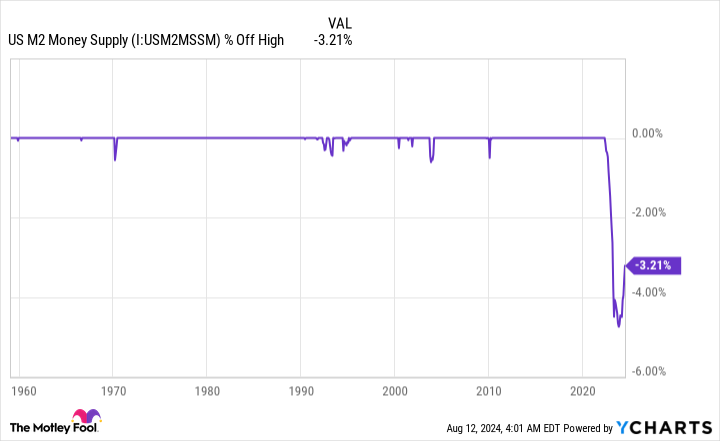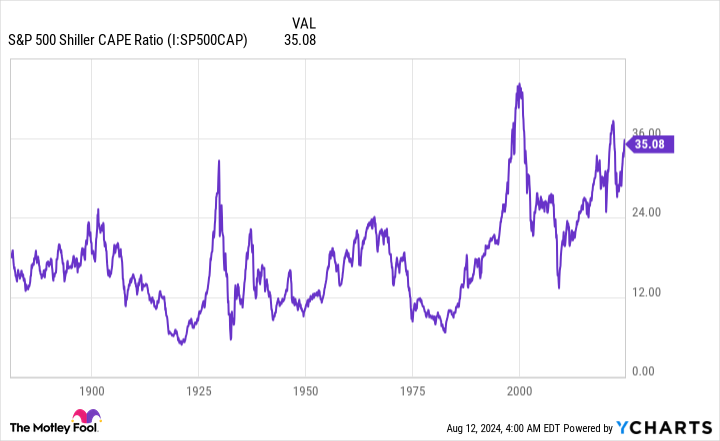Between early 2023 and mid-2024, the bulls firmly held sway on Wall Street. The rise of artificial intelligence (AI), the return of stock split euphoria, and better-than-expected corporate earnings/economic data helped propel all three major stock indices to multiple record highs.
But as history has repeatedly shown, the stock market does not move in a straight line upward. Recently, the growth-oriented Nasdaq Composite entered correction territory, with the index losing nearly 1,400 points, or about 8% of its value, in the first three trading days of August.

The ingredients for a stock market crash or bear market decline Doing Crashes happen, and historically, crashes provide an excellent opportunity for long-term investors to open positions or add to their existing holdings in high-quality companies.
While I have some stocks I want to buy if the broader market sell-off accelerates, there is one in which I’d like to triple my existing stake: a virtually unknown company offering a market-crushing 11% yield.
The ingredients for a stock market crash are there
Let me open this discussion by pointing out that no economic data point, metric, or forecasting tool can predict the short-term future with 100% accuracy. However, there are certain metrics and events that strong correlated with major moves up or down in the broader market throughout history – and I’m a big fan of history that rhymes with Wall Street.


As an example, we have seen the first meaningful decline in the U.S. M2 money supply since the Great Depression in the past two years. The M2 money supply takes into account everything in M1 (cash and coin in circulation, along with checking account deposits) and adds savings accounts, money market accounts, and certificates of deposit (CDs) under $100,000.
Most economists pay little attention to the money supply because it has been rising so consistently for 90 years. This means that a growing economy needs more capital to facilitate transactions. However, there has been a decline of more than 3% in M2 since its peak in April 2022.
Last year was only the fifth time in 153 years that M2 fell by at least 2% on an annual basis. The previous four times, which occurred between 1878 and 1933, coincided with periods of economic depression and double-digit unemployment. Although a depression very Although unlikely today, a decline in discretionary spending, fueled by a reduction in M2, signals that a recession is coming.


Additionally, the Shiller price-to-earnings (P/E) ratio of the S&P 500 suggests that stocks have historically been expensive. The Shiller P/E is also known as the cyclically adjusted price-to-earnings ratio, or CAPE ratio.
The Shiller P/E, which is based on average inflation-adjusted earnings over the previous 10 years, closed at 34.47 on Aug. 9, about double the average reading of 17.14, which goes back to January 1871.
But the most troubling aspect of the S&P 500’s Shiller P/E is how the broader market has reacted after it has exceeded 30. This has happened just six times, 153 years ago. After the previous five times, Wall Street’s major stock indexes lost between 20% and 89% of their value. In other words, premium valuations are not tolerated by investors over long periods of time.
The M2 money supply, the Shiller P/E, and other leading indicators strongly suggest that a bear market or outright crash is coming.


This 11% yielding stock is a phenomenal buy during times of panic
If the stock market falls, the little-known, ultra-high-yielding stock I want to triple my position in is Business Development Company (BDC) PennantPark Floating Rate Capital (NYSE: PFLT).
A BDC is a company that invests in the debt or equity (common and/or preferred stock) of companies in the middle market, that is, generally unproven small- and micro-cap companies. While PennantPark had nearly $209 million in various preferred and common stock positions as of June 30, with its $1.45 billion in first-lien secured debt, it is a primarily debt-focused BDC.
The benefit of focusing on debt is all about returns. Because most mid-market companies have limited access to traditional financial services, PennantPark is typically able to generate returns on loans that are well above the market average. It achieved a weighted average return of 12.1% on debt investments through mid-2024.
More importantly, PennantPark Floating Capital’s entire debt portfolio is variable. The most aggressive rate hike cycle in four decades has helped PennantPark’s weighted average yield on debt investments increase by 470 basis points since September 30, 2021. Even with widespread expectations that the country’s central bank will begin a rate-cutting cycle next month, the firm’s weighted average yield on debt investments will remain several times above the prevailing inflation rate.
The biggest concern with a small-cap BDC that focuses its lending efforts on generally unproven companies is how well those borrowers will do if the U.S. economy weakens. Fortunately, PennantPark’s management team has taken steps to properly monitor its lending and protect its capital.
For example, the firm’s $1.66 billion investment portfolio, which includes equity investments, is spread across 151 companies. With an average investment size of “only” $11 million, no debt or equity deal is critical to the firm’s success.
In addition, all but $1.2 million of PennantPark’s $1.449 billion debt portfolio is first-lien secured. In the unlikely event that one of the company’s borrowers files for bankruptcy protection, first-lien secured creditors would be first in line for repayment.
The measures taken by PennantPark to properly screen medium-sized companies and protect capital have resulted in a reasonably low non-accrual (default) rate of 1.5% of the portfolio cost price as at 30 June.
The company’s valuation is the final piece of the puzzle that would entice me to triple my existing stake. At the closing bell on August 9, the shares were trading 4.4% below the generally accepted net asset value (NAV) per share of $11.34. It’s not uncommon for short-term, emotion-driven panic selling during bear markets and stock market crashes to push companies like PennantPark briefly well below their NAV. Typically, BDCs trade very close to their NAV.
PennantPark Floating Rate Capital should have no trouble meeting its monthly (Yes, (monthly!) payout of $0.1025 per share, which currently equates to an annual yield of 11.4%.
With my dry powder ready, I would gladly seize the opportunity to triple my position in this inconspicuous source of income.
Should You Invest $1,000 In PennantPark Floating Rate Capital Now?
Before you buy shares in PennantPark Floating Rate Capital, you should consider the following:
The Motley Fool Stock Advisor team of analysts has just identified what they think is the 10 best stocks for investors to buy now… and PennantPark Floating Rate Capital wasn’t one of them. The 10 stocks that made the cut could deliver monster returns in the years to come.
Think about when Nvidia made this list on April 15, 2005… if you had $1,000 invested at the time of our recommendation, you would have $641,864!*
Stock Advisor offers investors an easy-to-follow blueprint for success, including portfolio building guidance, regular analyst updates, and two new stock picks each month. The Stock Advisor has service more than quadrupled the return of the S&P 500 since 2002*.
View the 10 stocks »
*Stock Advisor returns as of August 12, 2024
Sean Williams has positions in PennantPark Floating Rate Capital. The Motley Fool has no position in any of the stocks mentioned. The Motley Fool has a disclosure policy.
Meet the little-known 11%-yielding dividend stock I want to triple my stake in if the stock market crashes originally published by The Motley Fool




